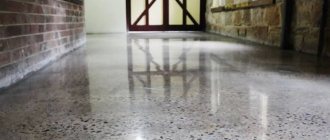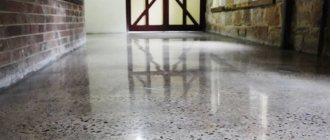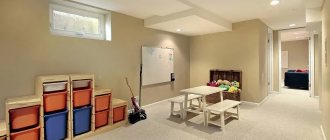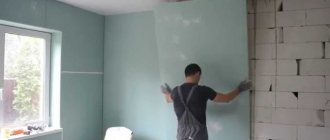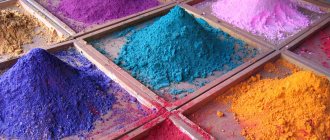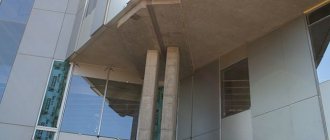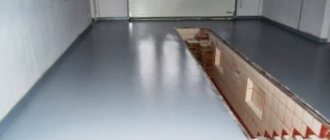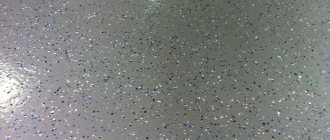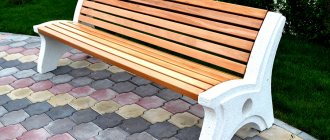Marble chips are one of the most interesting finishing materials. It is used in facade decoration, steps, tabletops and window sills are made from it, and it also makes elegant mosaic floors. Let's figure out what features this flooring has, what technologies are used to make it, and what characteristics it has.
Mosaic terrazzo floors in the interior of the living room Source tilebar.com
What is a concrete mosaic floor called?
The classic mosaic floor made from marble chips contains only natural ingredients: lime or its derivatives (cement mixtures), as well as crushed marble of different shades. Mosaic concrete coverings can be seen in educational and medical institutions, in hotel lobbies and corridors, in shopping areas and industrial premises.
Mosaic concrete, like any natural material, has an ancient history. The first prototypes of decorative coverings existed in Ancient Rome. The technology was developed in the Venetian Republic, where it became known as “terrazzo”. Since the 16th century, screed-based terrazzo floors have spread throughout Europe; in Russia they were designed for the palaces of Moscow and St. Petersburg.
A mixture of concrete and crushed marble of different shades allows you to obtain a mosaic surface, which, unlike the marble itself, has a characteristic speckled texture. Modern mixtures include polymer compositions and various additives.
Characteristic texture of terrazzo Source poly-msk.ru
How is terrazzo used in interiors today?
The products are used not only for floor coverings. Sometimes they are used to make accents on the kitchen apron and bathroom walls. Items made of terrazzo in the form of furniture sets, lamps and other household items are surprising. The color and texture of concrete briquettes allow you to imitate the colors of animals and textiles. The stone has always been distinguished by its special style, richness and effectiveness. Designers very often use finishing to implement the loft and hi-tech style. The tiles highlight the industrial motifs of the big city well. For this, gray, brown and brick shades are chosen. Great opportunities open up for specialists when creating a bathroom in an oriental style. Products with patterns reminiscent of the baths of Ancient Rome are placed here. The seamless nature of the tiles visually expands the space of the room.
Advantages and disadvantages
Mosaic floors are considered an attractive solution. They give any room an elegant look; You can choose their colors based on your own tastes and design goals. The popularity of terrazzo is explained by the following set of performance characteristics:
- Increased compressive strength of the mosaic floor. Compared to standard concrete pavement, it increases by 70-120%.
- Increased resistance to impact loads (for example, an accidentally dropped cup will not damage such a floor).
- Wear resistance. Due to its low abrasion, the coating is suitable for high-traffic areas.
- Water resistance. A floor with a mosaic texture is suitable for rooms with high humidity, such as a bathroom or kitchen.
- The coating is not afraid of elevated temperatures; suitable for a room with heated floors.
- The material does not fade under the influence of ultraviolet radiation and does not emit harmful substances. It is easy to clean and inert to household chemicals.
Owners choose a self-leveling floor with marble chips, focusing on the following properties:
- High production speed using pouring technology. The terrazzo imitation coating is completely ready for use within 6-8 days.
Terrazzo is a practical coating with low abrasion Source radugakeramiki.ru
- If necessary, you can make a thin (from 15 mm) and ultra-thin (from 6-8 mm) layer; in this case, the filler is also selected as fine. By reducing the thickness, the cost of terrazzo flooring is significantly reduced.
The following features of the self-leveling floor are considered disadvantages:
- The coverage can hardly be called budget.
- Making a floor with a complex pattern or design takes a lot of time.
- The use of a low-quality composition and violation of technology can result in a decrease in the decorative quality of the surface (it may turn yellow).
- At home, the floor must be supplemented with a heating system, and this results in additional costs.
Features of terrazzo floor tiles
The structure of the briquette includes concrete and marble chips. It is the latter that creates amazing patterns on the surface. They are characterized by: • soft shine; • attractive texture; • variety of shades.
The product is based on screening cement. It is laid in the so-called foundation of the model. The wear layer consists of several materials: • marble chips; • factions; • cement. This part is 8 mm thicker than the base. The color comes from durable pigments.
Types of terrazzo mosaic tiles
There are several types of products. The classification is based on the color shades of cement: • gray; • white; • color. The features of these materials allow us to expand the range of products and solve the most complex tasks of designers.
Production technology
The process of creating briquettes is quite complex. To implement the project, high-tech equipment is required.
The note! Samples are obtained by molding a semi-liquid material in a special container. It creates a lot of pressure. This method is called hyperpressing mixtures in a liquid state with filtration.
When making concrete mosaic terrazzo tiles, strict manufacturing steps are followed. First, inert (non-metallic) materials are weighed. Among them are rock screenings. The weight of cement and pigments is determined. The resulting components are combined in a special mixing machine. At the same time, the mixture is moistened. After the material is ready, it is fed into the dispenser. The system unloads concrete into a mold for pressing. She succumbs to high blood pressure. This is how tiles of a certain shape are obtained.
The peculiarity of the hyperpress is its ability to filter excess moisture. This allows us to produce a high-quality product and increase its durability. The next step is to unload the product from the mold onto a special device called a technological pallet. This is where another important production process takes place - hardening of the tiles. It can dry naturally or using the steaming method. The appearance of the product is of great importance. Therefore, much attention is paid to the final stage of manufacturing. The front part of the product is processed with a polishing machine. After finishing, the goods are packaged and delivered to customers.
Pros and cons of tiles
Undoubtedly, terrazzo has more advantages than disadvantages. Among the advantages: • high strength; • non-flammability; • ability to withstand strong impacts and resist ultraviolet radiation; • durability; • environmental Safety; • antistatic; • resistance to aggressive reagents; • aesthetics.
Thanks to high-quality materials, the product is not afraid of high humidity. As practice shows, briquettes are able to withstand large external loads.
Important! Buyers need to be aware of the wide range of applications of the products. It is recommended to be used not only in residential premises, but also at production sites, garages, warehouses, restaurants, offices, kindergartens, and schools.
Terrazzo floor tiles are made from materials that do not burn. Therefore, the products are used in the oil and gas industry. There are several dozen types of tiles. They differ in patterns and color shades. Today, a client can order the marble pattern he wants. The geometry of the tile is perfectly flat. This makes the work easier when laying it, since the deformation of the seams is minimal.
A special feature of the product design is the absence of chamfers around the entire perimeter. Thus, it is very simple to lay a seamless monolithic floor. The products are made from substances that are not capable of releasing harmful elements into the atmosphere. They also do not attract dust and are very easy to clean. The outer side of the tile has a universal coating. Thanks to this, it looks good in rooms of any purpose.
The disadvantages of concrete-marble products are primarily related to the composition of the material. Since it is based on concrete, the floor in the living room will be cold. Therefore, the coating needs to be insulated. The ideal option would be to install water or electric heating underneath. Another disadvantage of terrazzo is the color change. It turns yellow over time. However, this problem is easily solved. To restore its former beauty, it is enough to polish the surface.
The note! mosaic flooring is a durable coating. It is very difficult to dismantle. Thus, over the years, the owners may get tired of the drawing. To prevent this from happening, you need to choose neutral color shades in advance, and not flashy or trendy colors.
Types of mosaic floors by type of binder
Thanks to modern technologies, mosaic floors made of marble chips have become more diverse in composition. In addition to cement and marble chips, they contain crushed quartz and granite, and various polymer additives. Modern floor coverings are divided into three types based on the type of binder.
Cement
Classic coating has the following features:
- The binder is Portland cement.
- The laying technology is standard, as for a concrete mixture.
Terrazzo with large texture Source importers.co.il
- The thickness of the coating starts from 5 cm, the thickness of the filler is up to 2 cm.
- It is possible to use reinforcement (depending on the installation location).
- If it is necessary to reduce the price of the material, use a ready-made concrete mixture (produced at a mortar-concrete unit).
- The finished terrazzo mosaic floor is sanded and then impregnated with a polyurethane impregnation. This allows the pattern (filler) to appear well on the surface. The treated surface becomes sealed and dust free, making it easier to keep in order.
Polymer-cement
The composition is characterized by the following features:
- The binder consists of a mixture of Portland cement and special polymer modifiers.
- When laying, the technology of thin-layer concrete screed is used.
- The composition allows you to form a thin (from 1.5 cm) screed, which can be useful in rooms with a low ceiling.
- The thickness of the filler is limited by the thickness of the finished coating; with a minimum of 1.5 cm it does not exceed 1 cm.
- To obtain purer, brighter colors, regular cement can be replaced with white. A mosaic floor will be more expensive, but will have improved decorative qualities.
Using mixtures of different shades Source beton-house.com
- The polymer-cement mixture is prepared directly on site; You can use a forced or inertial type concrete mixer.
- Before starting work, the base is primed without contact, which helps increase its adhesion. It is important that the surface is clean and dry when applying primer.
- The finished polymer-cement coating is polished or impregnated with polyurethane impregnation.
Polymer concrete
The polymer concrete mosaic floor meets the following parameters:
- The binding component is a polymer composition (polyurethane or epoxy).
- The technology of quartz-filled self-leveling floors is used for the arrangement.
- The thickness of polymer concrete coatings varies from 20 to 50 mm.
- The filler is quartz sand, possibly with pigment; size starts from 0.5 mm.
- For decorative purposes, a variety of flocks, sparkles, glitters (acrylic, metallized, reflective) are added; particles can have different shapes, sizes and colors.
Seamless texture of mosaic floor Source stroyka-gid.ru
- To create the front layer, transparent polymer compounds are used that increase the moisture resistance of the surface.
See also: Catalog of companies that specialize in finishing materials and related work
Terrazzo tile laying technology
When installing floor products, you should follow the rules. Otherwise, they will not withstand the load and will become deformed. First of all, pay attention to the base. It should be strong and not damp.
Important! The tiles must not be mounted on elastic or medium-elastic insulating materials such as polystyrene or fiberglass. They must be filled with concrete screed. Its layer should not be less than 4 cm.
If the floor is made of artificial materials, it is not recommended to lay briquettes close to the wall. The master must leave a so-called expansion joint 1.5 cm wide. In order for the quality of work to be at the proper level, tools should be prepared. Rectangular tiles are easy to lay end-to-end. In this case, ordinary tile adhesive is used. If the preliminary filling and installation were carried out correctly, then the following will never appear on the floor: • deformations; • cracks; • swelling.
The pattern on the surface will be uniform and form a single composition.
On the principles of creating a decorative effect
The decorative properties of floors made of marble chips are formed in the following ways:
- If you need a light floor, use white Portland cement; for a dark coating, prepare a solution based on Portland cement grades M400 and higher.
- For laying colored coatings, colored Portland cement is chosen, the use of which is regulated by the technical standards of GOST 15825.
- Mineral pigments can be used to color the composition. The more there are, the more intense the shade will be, the maximum possible amount in the composition is 15% (by weight).
- Alkali- and ultraviolet-resistant substances (for example, manganese peroxide, chromium oxide) are used as pigments. Mineral additives are ground in a paint grinder and added to the mixture in the form of a suspension.
Mosaic floor with a mirror surface Source yandex.net
- General rule: the size of marble chips granules should not exceed 60% (0.6) of the thickness of the floor itself.
As a rule, mixtures with the following proportions are used for terrazzo mosaic concrete floors: crumbs occupy 75-80%, and cement 20-25%. Only in this case will the surface have the correct mosaic texture. It is important to carefully ensure that no foreign inclusions get into the composition, and that the filler is distributed evenly and does not form lumps.
Decorative mixtures
There are many recipes for obtaining mosaic floors in the required palette; The following mixtures are often used (dry ingredients are indicated in parts, pigment - in% of the total weight):
- Black mosaic floor. 3 parts black stone chips, 1 part cement (grade M400 and higher), 5% manganese peroxide.
- Light. 1 part cement of the same quality, 0.3 parts white stone flour, 2 parts crumbs of choice.
Color palette of popular terrazzo shades Source elitsmesi.ru
- Red and white. 1 part Portland cement (M400 and above), 3 parts white chips, 3% red lead (powder, rich brown-red iron oxide).
- Black and white. 1 part Portland cement of the same quality, 3 parts crumbs of any light-colored mineral, 12.5% manganese peroxide.
- Yellow. 1 part white Portland cement, 3 parts yellow stone chips (for example, zlatolite), 10% dry ocher (pigment).
- With granite surface effect. 1 part Portland cement, 1 part white marble, 2 parts granite chips.
Properties and structure of the coating
The mosaic-concrete coating demonstrates excellent performance properties and a long service life. The main advantages of mosaic concrete: high resistance to wear, moisture, mechanical stress, aesthetics, hygiene, ease of use, durability.
The coating consists of two layers - first a cement screed 20 millimeters thick is applied, then concrete with filler 25 millimeters thick. Each layer is made using a specific technology. The binder is Portland cement brand M400 (can be colored or white).
Be sure to add a brightener to the concrete - flour from marble (or other material) chips of a light shade in a volume of 20-40%.
Granite, basalt, marble, and any other stone chips ranging in size from 0.025 to 0.15 centimeters are added as filler. The maximum allowed volume is 80%. Pigments are also added to the composition - natural or artificial dyes that give the desired shade to the concrete mosaic. Pigments are mixed dry with cement, the maximum volume of pigment is 15% of the total volume of the mixture.
Variety of fillers
In the Middle Ages, crushed terracotta served as floor filler in Venice, then it was replaced everywhere by marble chips. Today, the appearance of mosaic floors has become much more diverse thanks to the use of the following materials:
- Minerals. Crumbs of natural origin are used; In addition to marble, slate, granite or, for example, semi-precious serpentine or jasper are allowed. Preference is given to traditional marble chips; it can have different shades, sizes and textures.
Mixture with natural and polymer fillers Source dekorator-s.ru
- Sand. Sand additives are used in the form of fractions no larger than 1-2 mm. The sand is pre-sifted and washed.
- Metals. Particles of metallized foil made of aluminum, bronze or copper are used.
A universal decorative material is chips (flocks) - particles of paint or polymers (for example, vinyl), or glitter - polymer sparkles. The flock palette is more diverse, containing matte, neon and mirror varieties. The palette of vinyl chips is close to natural colors; they are suitable for simulating natural minerals.
Flocks are applied to the newly applied coating; if it is poured, then after rolling with a needle roller. There are three application methods:
- The chips are tossed up so that they are more evenly distributed over the surface. With this method, the material consumption is 20-80 g per square meter.
Composition with contrasting color selection Source wallsandfloors.co.uk
- The surface is covered with a continuous layer, the consumption increases to 80-100 g per square.
- Use a pneumatic spray gun. The air jet blows particles into the coating, creating a more complex, three-dimensional effect. Material consumption will be maximum, 200-700 g per square.
After backfilling, the mixture is allowed to dry, then the floor is cleaned in different ways: with a brush, sandpaper or spatula. Then the surface is dusted and covered with one or two layers of varnish.
About the intricacies of making a seamless concrete mosaic floor
There are SNiP standards (2.03.13-88 “Floors”) related to mosaic floors made of marble chips; the technology is based on the following restrictions:
- The traditional thickness for seamless terrazzo floors does not exceed 30 mm.
- Parameters of marble chips: size no more than 15 mm, and it should not exceed 0.6 of the thickness of the floor.
Installation of mosaic floors with dividers Source ppt-online.org
The rules apply to cement and polymer-cement mixtures; The thickness of polymer varieties when applied does not exceed 5-10 mm.
To obtain a durable coating, the microclimate of the room is important. The higher the quality of the terrazza screed, the more humid the air. At low humidity, additional moistening of the coating is carried out. To do this, the fresh mosaic-concrete surface is covered with sand (or sawdust) and moistened using a hose with a watering nozzle.
You also need to remember about the characteristics of concrete. This material gains 70% strength within the first 24 hours; It will take about a month to achieve design strength (depending on humidity and temperature). The first week after installation is considered critical; during this time it is better not to load the floor at all. If it is necessary to speed up the hardening process, additives are added to the mixture to increase strength.
Seamless concrete floor in the interior of an apartment Source hsmedia.ru
Pros and cons of gender
- The colors and stains can be changed, allowing for a wide variety of designs.
- Terrazzo floors are relatively lightweight and durable.
- The customization options for terrazzo flooring are endless.
- The mottled texture and tough base material make painting difficult.
- When terrazzo flooring is properly sealed, it is non-porous and mold resistant.
- Because terrazzo is made of durable materials such as cement, it is very durable, which is why it is so often used in public and commercial buildings.
- Elegant and timeless, with endless design possibilities,
- Low maintenance costs and life cycle Terrazzo meets VOC requirements
- Superior chemical resistance and lowest maintenance costs among solid surface floors.
- Better color uniformity and performance.
- Fast curing, faster turnaround ensures high productivity.
- On-site application provides a monolithic surface and saves space, time, transportation costs, etc.
Terrazzo floors can virtually last the life of the building.
Nice, clean and tough
Terrazzo floors are simply stunning as the pieces of shiny aggregate catch the light and create a shimmering effect. Natural stone chips such as marble, granite and quartz are the best choices for finishing terrazzo, but other types of aggregates are also used, including glass pebbles, synthetic chips and silica chips in an endless array of colors. Experienced installers can create intricate designs that transform ordinary walkways into works of art. Terrazzo is durable and resilient, and its non-porous nature resists staining and bacteria absorption, making it the best choice for high-traffic areas.
Expensive, slippery and hard
- Installing terrazzo floors is a job strictly reserved for professionals and is labor intensive, meaning it is one of the most expensive types of flooring.
- Terrazzo also tends to be slippery when wet.
- Falling on terrazzo flooring is similar to falling on concrete sidewalk, so homes with small children or elderly residents may be better off choosing a different flooring.
Making cement and polymer-cement concrete terrazzo mosaic floors
The installation of terrazzo mosaic floors using classical technology is considered a creative task, and therefore requires attention and accuracy from the performer at all stages of the work. The quality of the future coating also depends on the preparation of the rough surface, which has the following requirements:
- The surface must be so level that the average deviation from the plane does not exceed 5 mm. Smaller defects (scratches or bumps) are allowed.
- The surface should be dense and uniform, without dirt, peeling, or efflorescence.
Therefore, the rough layer is leveled, significant defects are sealed with a cement-sand mixture, and thoroughly cleaned (it is better to use a construction vacuum cleaner). It is useful to strengthen the material with a specialized primer, and before applying terrazzo, be sure to moisten it with water.
Metal or glass strands are used to separate colors Source yandex.net
Before making a marble floor, markings are made: using a level, marks are placed around the perimeter, setting the height of the finished floor. Guide beacons are installed along the clean level (in increments of 1.5-2 m). They will help in pouring a solid one-color floor, and especially in pouring sections (spruce design includes various shades, shapes or patterns). It is also convenient to apply marking lines for sectional floors using a tapping cord.
History of origin
Terrazzo (which means “terrace” in Italian) originated in the Mediterranean region several hundred years ago.
It was made by pressing stone chips into the surface of natural clay and then sealing it with goat's milk to create a mosaic-like appearance.
Eventually, cement replaced the clay, and pieces of glass and painted tiles ended up on the surface of this decorative floor.
Modern terrazzo includes polymers, resin and epoxy that improve texture, reduce cracking and increase durability. Today's terrazzo is hard, dense and impermeable, requiring no surface sealer, although buffing and buffing will highlight and maintain its lustrous shine.
Video description
About making a mosaic floor in the following video:
To create patterns, special separating cores with a thickness of 4-5 mm are used. They can be glass or metal (copper, brass); To fix the cores, use special fasteners or place them on a solution. After installing the cores, perform the following operations:
- Pour the composition between the guides, with a slight influx on the beacons (this is necessary for proper compaction).
- The lighthouses are dismantled, their traces are filled with solution.
- The fresh solution is tamped, manually (tamper and trowel) or using equipment (for example, a vibrating screed). The operation smoothes and compacts the concrete layer and compacts the protruding edges of the filler.
Sanding a mosaic floor Source pol-exp.com
Necessary tools and equipment
The easiest way to make thin-layer terrazzo floors is that no special tools are required to apply the solution and such floors do not need to be sanded. If cement or polymer-cement compositions are used , then you will need the following tools:
- building level;
- laser level;
- rule;
- chop cord;
- trowel;
- ironer;
- manual rammer;
- vibration machine;
- mosaic grinding machine for concrete;
- abrasive stones of different grain sizes;
- industrial vacuum cleaner;
- boots and knee pads.
Making a polymer self-leveling floor with imitation terrazzo
Since the technology involves the creation of a very thin polymer coating, the preparation of the rough surface must be especially careful. The plane is leveled with a maximum deviation of 2 mm per meter (no more than 5 mm for the entire size), then cleaned and a special primer is applied to create a rough layer.
Self-leveling floor with imitation of natural texture Source promdekorpol.com.ua
A self-leveling floor that imitates terrazzo (like other varieties) practically does not require finishing level markings or beacons. The mixture itself is distributed in an even layer under the influence of gravity, and the difference between the finished and subfloor is a couple of millimeters. At this stage, the floor is marked for installation of veins.
When the veins are installed, the solution is poured onto the surface; Excess air is removed using a needle roller. If it is necessary for the coating to be uniform, there should be enough mixture to fill the entire area. Otherwise, it is almost impossible to avoid color difference.
When the floor is ready, special wax is applied to it and processed using a polishing machine. The procedure not only polishes, but also compacts the decorative layer, which has a beneficial effect on its strength.
Seamless mosaic covering in a modern interior Source homespure.com
6. Preparing the base and pouring the screed
The final appearance and evenness of the entire mosaic floor depends on how high-quality and even the concrete screed is. Please note that the screed will lie evenly and will not subsequently crack only when applied to a carefully prepared subfloor. To do this you need:
- Remove the remnants of the old coating, as well as the remnants of adhesives and other solutions on which it could adhere;
- Removing greasy oil stains and other contaminants;
- If cracks are found on the surface, they must be cut using a grinder and the void filled with cement. Pay special attention to the places where heating pipes exit. Usually there are holes around them that lead into the voids of reinforced concrete floors;
- When all defects have been eliminated and the solution has finally crystallized, it is necessary to roughen the surface to improve adhesion. To do this, you can carefully walk over the subfloor with a stiff wire brush;
- Now, using a construction vacuum cleaner, you need to carefully remove dust from the surface;
- Apply several layers of deep penetration primer and let it dry completely;
- After this, you need to decide on the required height of the concrete screed. It is recommended to maintain a value of at least 2 cm. This is the minimum limit. The curvature of your base will determine the maximum. It is necessary to find the highest point, add the height of the construction beacon and make a mark on the wall at the appropriate height;
- Using a laser level or a blue-painted cord, you need to mark a level around the perimeter of the entire room;
- Check again whether the mark covers all differences and unevenness of the floor, taking into account the height of the beacons;
- Set the beacons at a distance equal to the length of your rule from each other. They are installed on the same cement mortar. Do not forget to always control the mutual evenness of the beacons using a long building level;
- Wait until the cement mortar dries and check that the beacons are motionless and do not bend. If necessary, make additional fixation points with the solution;
- Mix the mortar for the mortar in a concrete mixer, distribute the mixture between the first two beacons and stretch it evenly using the rule;
- Thus, you need to fill the entire surface;
- After this, cover the screed with film or sprinkle with tyrsa to avoid its premature drying and cracking;
- Once a day you need to spray the screed with water.
When the solution begins to set, you need to remove the construction beacons, and then fill the voids with the solution. When you can walk on the screed freely, you can begin sanding it, if necessary. After which you can begin to form a drawing of the future mosaic floor.
Briefly about the main thing
Terrazzo mosaic floors have remained in demand since the time of the Venetian Republic, and today they can be found in a wide variety of spaces. The mosaic-concrete floor performs two functions: decorative and leveling, and is suitable for use in a country house.
There are three types of terrazzo floors, differing in the type of binder. To impart decorative qualities, fillers of natural and artificial origin are used, as well as pigments to enhance color.
The technology for making cement and polymer-cement mosaic floors differs from making polymer self-leveling floors. It requires careful marking of both the floor level and the location of the dividing conductors. The self-leveling installation takes less time, but also includes a final polish.
Other types of coatings
Concrete of a mosaic composition is used not only in the arrangement of floors using the technology of mixing different components and even pouring. In modern construction, concrete is often used to create cast marble, produce mosaic concrete slabs, and elements for decorating public and private buildings.
These options make it possible to realize any design idea and use a variety of pigments and concrete fillers, which have unusual decorative properties and allow you to create unique and exclusive floor coverings.
Terrazzo mosaic coverings
Such coatings differ from conventional mosaic floors in their composition and thin-layer structure.
- A cement coating made of Portland cement and fillers of a fraction of 20 millimeters is poured to a thickness of 5 centimeters, then the floor is polished with special polishing substances.
- A polymer-cement coating made of 10-millimeter fraction filler, cement and polymers is poured into a layer 1.5 centimeters thick and a fine finish is made (polished and impregnated with polymers).
- When constructing a polymer concrete floor, Portland cement is used with quartz sand of a fraction of 2 millimeters and epoxy or polyurethane compounds. The thickness of the mosaic layer is 2 millimeters. The final coating is made from transparent polymer compounds.
Pouring terrazzo mosaic concrete is carried out using universal technology, with the exception of the finishing layer, where everything depends on the type of filler, the components included, and the features of working with them.
Concrete mosaic slabs
The slabs are made from one or two layers of concrete prepared from a mixture of Portland cement grades M300-M500 (colored or white), marble chips of different shades, pigments, and plasticizers. Standard slabs are produced in a square shape with sides of 30 or 40 centimeters, their thickness is 18-35 millimeters. The slabs are used for cladding surfaces both indoors and outdoors.
The main advantages of concrete mosaic slabs: increased level of resistance to wear, low temperatures, moisture, stability under different mechanical loads, significant compressive and tensile strength, intrinsic safety, durability, excellent aesthetic properties.
The slabs are produced by pressing, then ground and polished. Lay it on a base made of concrete or cement and sand, thoroughly dedusting it, moistening it and priming it with cement laitance. Usually, for laying slabs, a mortar of the M150 brand is chosen, the floor layer is 10-15 millimeters thick, then all the seams are sealed with liquid cement mortar.
